
Sponsor Appreciation Article Series
– 6 articles that highlight PHE America supporters –
Gopher has proudly served schools, athletic programs, community organizations, and countless institutions and programs for the past 70 years. We are dedicated to providing you with the products and services you need to increase activity, improve fitness, develop skills, create fun, and reach a higher standard of learning and living. We are proud to serve teachers, coaches, athletic directors, program directors, and athletes around the world and are committed to offering the best equipment available to help both young and old lead more active and healthy lives. This article was previously published in PHE America in 2019.
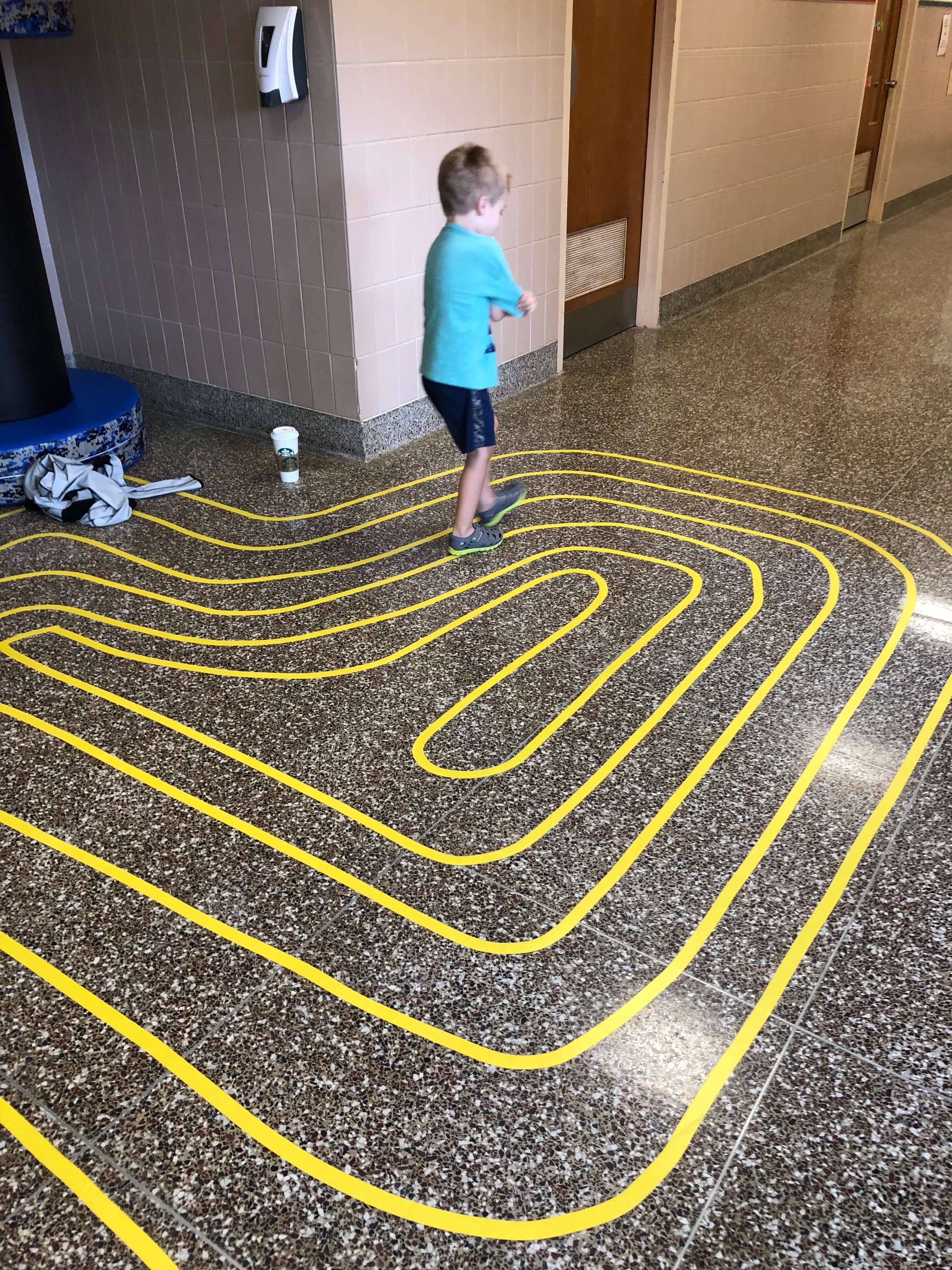
I have been teaching for about 18 years now and have observed many students struggle with focus and inattentiveness. In addition, my own son struggles with ADHD and motor tics, (there are times when he appears to want to dance out of his own skin). To assist him, my husband and I purchased a mini-trampoline, spinning chair, ninja line, door swing, and more. Our intent was to give him breaks to move during homework and studying to help him focus and attend.
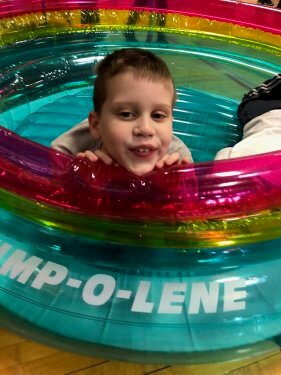
There are many students like my son in our classrooms. I’m convinced that we do not provide our students sufficient opportunities to move throughout the day due to increased academic demands, testing, etc. Our society is becoming more sedentary with the increase of technology and video games. Students are not getting the daily Physical Education they need. And too many teachers pull students out of PE classes to catch up on work they have not completed.
It especially frustrates me when recess time is taken away to do “bonus work” in the classroom. Our children are already not being given enough opportunities to gain the sensory input they need for learning! We urgently need to address this. When a child’s need to move goes unfilled, it can translate into inattentiveness, lack of drive, and impulsivity. We need to provide them with many varied opportunities to succeed and to move.
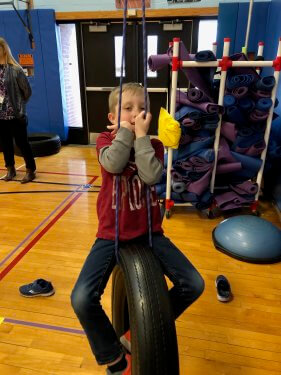
I am always searching for additional opportunities, outside Physical Education classes, recess, before school PE programs, and after school PE programs to keep students moving and practicing mindfulness. I truly believe that movement and mindfulness are the keys to success in all areas of life. Research has proven that cognitive connections and academic success can be improved through movement and play. Research also proves that mindfulness decreases stress, increases working memory, and helps to regulate emotions, as well as a host of other benefits. Movement and mindfulness are two of the best ways for students to control their behavior, focus their attention, and thereby retain more information and engage more in learning.
So, what can we do to provide our students additional opportunities to move and be mindful?
I am blessed to work with colleagues who understand the importance of Physical Education and see the connection between movement and academic success. I have witnessed many of my amazing colleagues write grants or purchase movement equipment with their own money for their classrooms. The classroom teachers and I already collaborate a great deal about PE equipment items they can borrow to assist their students.
Some of the items purchased or borrowed include exercise balls, sensory steps, bands, fidgets, steps, swings, and tunnels. These classroom teachers are providing opportunities for movement breaks in between lessons or when they see the students start to fidget. In addition, our school has mindfulness lessons being implanted into students’ weekly work. So what else can we do or add?
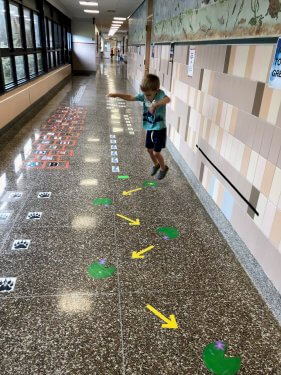
Last summer I learned about movement/sensory hallways. I loved the idea that students can request a movement break when they need it. If your school does not have a sensory hallway yet, get on it! The benefits are endless. But why limit the movement hallway to only the students who ask for it? Some students might not even realize that movement is exactly what their bodies need! Why not make movement an integral part of your school culture? I used to watch my students march like soldiers through the hallway to their next classes. I understand the need to be quiet through the hallways, but why not make it an opportunity to get more exercise and move with a purpose to improve health? Why not make EVERY hallway and space a movement and sensory hallway? And that is exactly what I did last year.
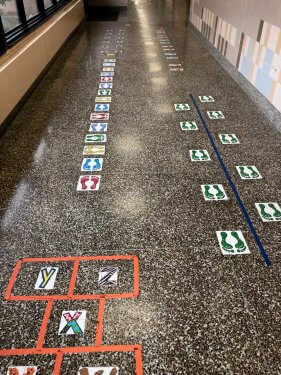
Our school’s lay-out is pretty much a rectangle. On one side (the side by the gym), I made the entire hallway a “movement hallway.” No matter which side of the hallway you walk on, there is a movement path for you. This side has constant movement because even if the students make noise when they are moving, it is not a problem since there aren’t many classrooms on this side. A lot of companies sell decals for the floor, but these can be expensive. Instead, I made my own on my computer, laminated them, and stuck them with Game Craft MatTapefrom US Games to the floor. The mat tape protects the decals, holds them down, and is not slippery.
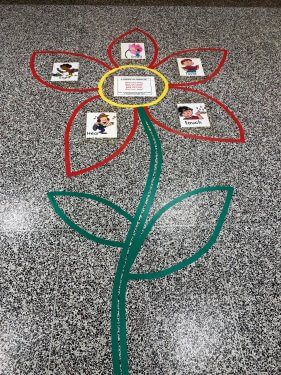
The other 3 hallways were “movement/mindfulness” hallways. The 2ndhallway was a “sensory walk.” This is the 1st grade-2nd grade side of the school and I wanted to pick an activity the students could do in the hallway that would not be distracting to the younger students in the classrooms. On the floor, I made a giant flower with 5 petals out of colored tape. On each petal was one of the 5 senses (sight, smell, hearing, taste, touch). In addition to the primary classrooms, the chorus room, band room, and cafeteria were also in this hallway. The students were trained that when they walked down this hallway, they had to use their “mindful” eyes (sight), nose (smell), ears (hearing), fingers and toes (touch). They had to pick one item in the hallway and “look at it as if it was the first time they were ever seeing it.” What did they notice?
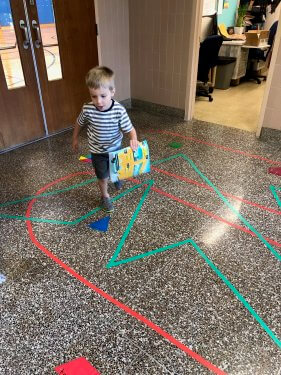
A lot of the students’ work was hanging on the walls, so this gave the students plenty to look at. Additionally, they had to use their sense of smell to figure out what the cafeteria cooks were cooking. What smells did they notice? Next, they had to pick a sound and listen to it mindfully. (Remember, the band and chorus rooms were in this hallway). I told them to try to listen to the sound mindfully from the beginning of the sound to the end. What did they notice? At the end of the hallway, I placed pieces of different sensory fabric on the wall and the students were encouraged to use their sense of touch. I purchased these pieces at Joanne’s Fabric. What did they feel or notice about the textures?
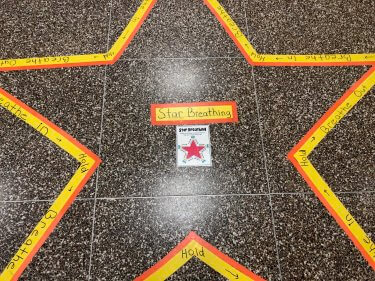
The 3rdhallway was dedicated to “star breathing.” I taped a giant star to the floor. Students were trained to take 5 mindful breaths. Breathing in for 3 counts, holding for 3 counts, and breathing out for 3 counts. They did this as they were walking in the hallway. After they did a cycle of 5 breaths, they had to do 5 moving jumping jacks (this helped reinforce the concept of the star breathing and got their heart rates elevated). This hallway hosted the art room, conference room, counselors, and school psychologist office. If the students made some noise when doing jumping jacks, it didn’t affect classroom learning.
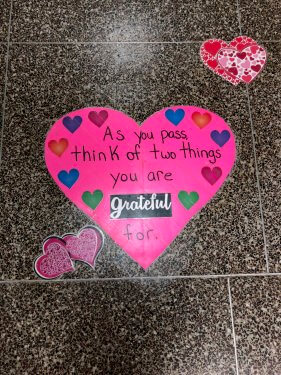
The 4thhallway was dedicated to gratitude and heartfulness. I taped giant hearts to the floor and down the hallway. As they walked in that hallway, they were instructed to think of three things they were grateful for. In addition, they placed their hands on their hearts and sent loving thoughts to someone. This hallway hosts all 3-5thgrade classes so I needed to make sure the activity wasn’t noisy or distracting. The gratitude and heartfulness activities were a perfect fit for this hallway.
The students loved the hallways and so did the parents and teachers. Some teachers just used the movement and mindfulness hallway while traveling from their classroom to a new location and others used it for a quick movement break in between tasks as well as when traveling. They would “go for a walk” with the students to get “fresh air.”
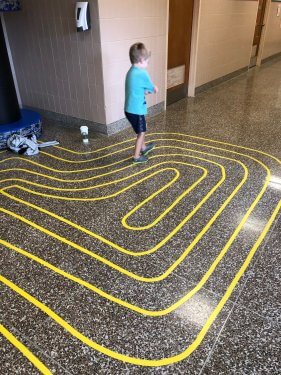
I also have a small storage room outside of the gym. I supply this room with equipment the students can use for an additional break. Aides working with the students will bring them to the room and have them pick equipment to use for an additional needed break. If the gym is not in use, they can go in and play inside. If I am teaching, the aides will have the students use the equipment in the hallway. It is always there for them to use anytime throughout the day. Students without aides who need a movement break are sent down by their classroom teachers with a timer. When the timer ends they return to class. I have never had a student abuse this privilege.
As Physical Educators, it is our responsibility to be advocates for our discipline and our students’ health. Join me in finding as many creative opportunities as you can to get your students moving!
(If you have questions just email me (ebolger@sayvilleschools.org). I’d be happy to share my sensory hallway ideas with you!)
